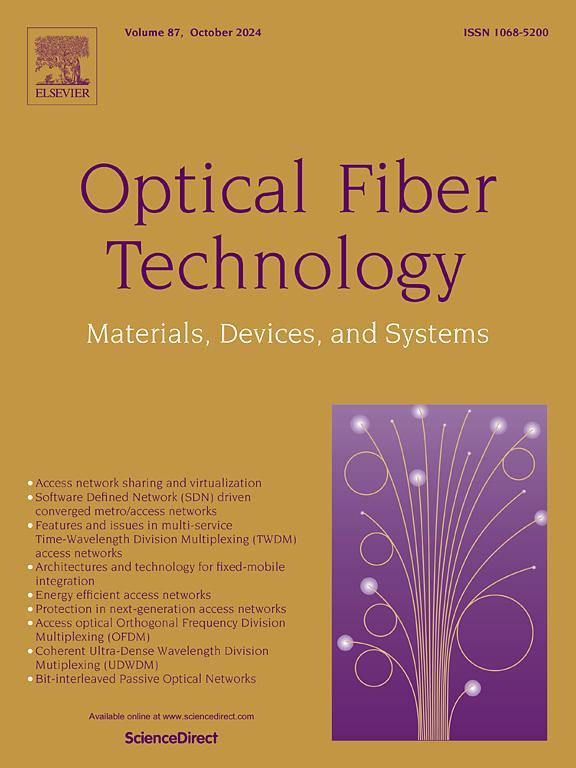Streamlining network operations of a gram panchayat, Indore India: A traffic offloading approach with tunicate swarm optimization algorithm
IF 2.7
3区 计算机科学
Q2 ENGINEERING, ELECTRICAL & ELECTRONIC
引用次数: 0
Abstract
In this digital era, access networks play a very crucial role in connecting users across diverse geographical regions, each with its challenges. Thus, during the deployment of access networks, utilizing network resources effectively and planning meticulously are essential to ensuring minimal waste and optimal infrastructure utilization. In the context of a fiber wireless (FiWi) access network, the proposed work examines various network parameters. Within FiWi network architecture, each network component has its own function to do, and among them optical network unit (ONU) is crucial to the network. It plays a very important role, as it works as a bridge between fiber and wireless access networks. Since the traffic handling resources of the ONU are limited, thus while transferring traffic, there are chances of bottleneck near ONUs. This may result in increased network delay along with inefficient resource utilization of ONUs, as some might get overloaded and some might be underloaded. Thus, the paper addresses the issue of overloaded ONUs by proposing a solution involving traffic offloading to underloaded ONUs via wireless connections. Offloading ensures effective resource utilization (RU) and improves the packet delivery ratio (PDR), along with lesser blocking probability (BP), but may suffer from increased network traffic delay. Hence, to address this issue, the proposed method uses the tunicate swarm algorithm (TSA) to reduce traffic offloading delay and the total traffic delay experienced by the traffic in the network. Redistributing traffic optimizes network resources, resulting in an enhanced user experience and cost-effective scalability in the face of rising wireless connectivity demands in various geographical regions. Thus, the proposed approach which relies on optimization for offloading is compared with before offloading and after offloading (without optimization) shows improvement in network performance parameters. Traffic offloading delay and total traffic delay lowers by approx. 25 % in comparison to without TSA optimization. RU and PDR improves by approx. 6 % and BP shows 25 % reduction in comparison to without traffic offloading. A practical scenario for a gram panchayat (GP) is also considered to check the effectiveness of the proposed work.
印度,印度,一个克村务委员会的精简网络操作:一种流量分流方法与束状虫群优化算法
在这个数字时代,接入网在连接不同地理区域的用户方面发挥着至关重要的作用,每个区域都面临着挑战。因此,在接入网部署过程中,有效地利用网络资源,精心规划,是保证浪费最小化、基础设施利用率最大化的关键。在光纤无线(FiWi)接入网的背景下,提出的工作检查各种网络参数。在FiWi网络架构中,每个网络组件都有自己的功能,其中光网络单元ONU (optical network unit)对网络至关重要。它起着非常重要的作用,因为它是光纤和无线接入网之间的桥梁。由于ONU的流量处理资源有限,因此在传输流量时,在ONU附近有可能出现瓶颈。这可能会导致网络延迟增加以及onu的资源利用效率低下,因为有些可能会过载,有些可能会负载不足。因此,本文提出了一种解决方案,通过无线连接将流量分流到负载不足的onu上,从而解决了超载的onu问题。卸载可以保证有效的资源利用率RU (effective resource utilization),提高PDR (packet delivery ratio),降低阻塞概率BP (blocking probability),但可能会增加网络流量延迟。因此,为了解决这一问题,本文提出的方法使用了tunicate swarm algorithm (TSA)来减少网络中流量的卸载延迟和总流量延迟。重新分配流量可以优化网络资源,从而增强用户体验,并在面对不同地理区域不断增长的无线连接需求时实现经济高效的可扩展性。因此,将本文提出的依赖于优化的卸载方法与卸载前和卸载后(未优化)进行比较,可以看出网络性能参数的改善。交通卸载延迟和总交通延迟降低约。与未优化TSA相比,降低了25%。RU和PDR提高了大约。6%, BP显示与没有流量卸载相比减少了25%。还考虑了一个克村务委员会(GP)的实际情况,以检查所提议工作的有效性。
本文章由计算机程序翻译,如有差异,请以英文原文为准。
求助全文
约1分钟内获得全文
求助全文
来源期刊

Optical Fiber Technology
工程技术-电信学
CiteScore
4.80
自引率
11.10%
发文量
327
审稿时长
63 days
期刊介绍:
Innovations in optical fiber technology are revolutionizing world communications. Newly developed fiber amplifiers allow for direct transmission of high-speed signals over transcontinental distances without the need for electronic regeneration. Optical fibers find new applications in data processing. The impact of fiber materials, devices, and systems on communications in the coming decades will create an abundance of primary literature and the need for up-to-date reviews.
Optical Fiber Technology: Materials, Devices, and Systems is a new cutting-edge journal designed to fill a need in this rapidly evolving field for speedy publication of regular length papers. Both theoretical and experimental papers on fiber materials, devices, and system performance evaluation and measurements are eligible, with emphasis on practical applications.
 求助内容:
求助内容: 应助结果提醒方式:
应助结果提醒方式:


